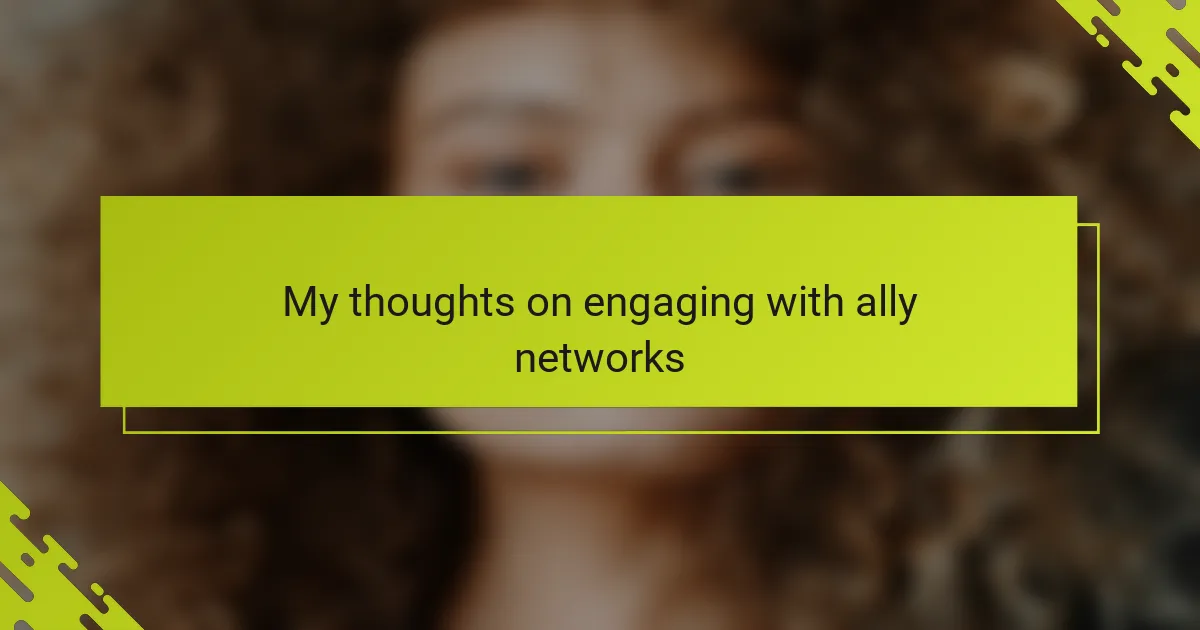Key takeaways
- Ally networks promote deep understanding through shared commitment and ongoing education, moving beyond mere support.
- Active participation fosters trust and amplifies the voices of marginalized communities, creating a sense of safety and belonging.
- Engaging with ally networks requires vulnerability, open communication, and a commitment to reflection and growth.
- Building strong connections is rooted in genuine curiosity, consistency in presence, and openness about personal learning journeys.
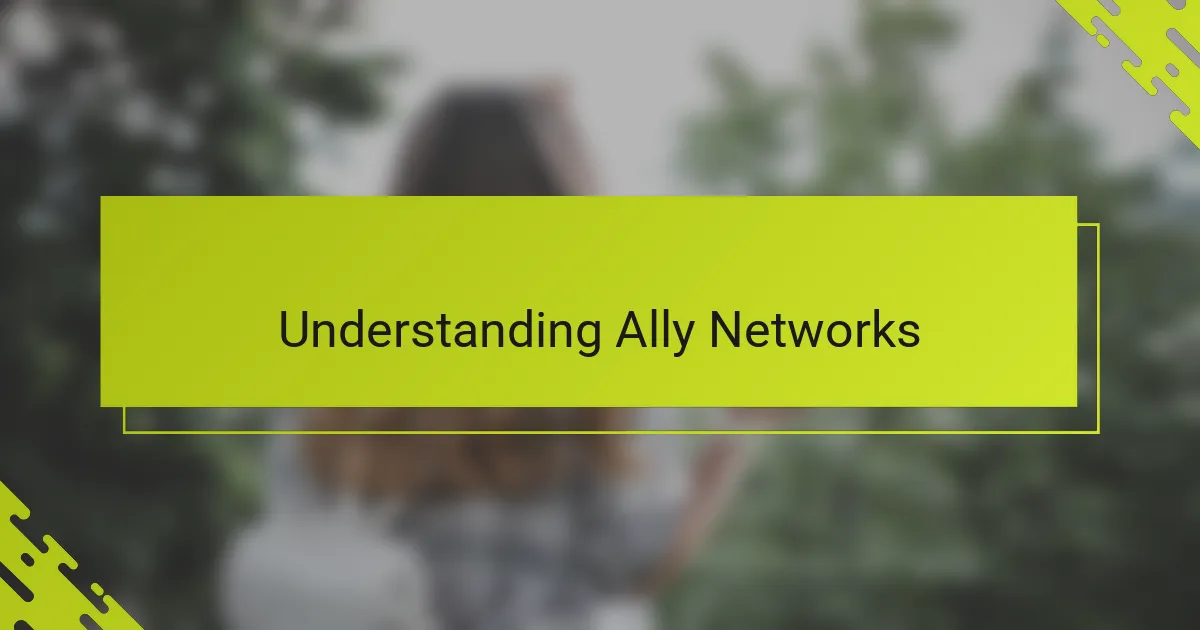
Understanding Ally Networks
Ally networks are often seen as bridges between communities, but what does that really mean in practice? From my experience, these networks become spaces where understanding deepens—not just through words, but through shared commitment and actions. Have you ever felt the difference between someone who simply supports you and someone who actively shows up for you? That’s the power of a true ally network.
When I first joined an ally network focused on queer women culture, I was struck by how much I learned—not only about the issues queer women face but also about how complex and intersectional allyship can be. It made me realize that ally networks aren’t just about support; they’re about ongoing education and accountability. In fact, they invite you to look inward and ask difficult questions about your own biases.
It’s also worth noting that ally networks vary widely. Some are informal and fluid, while others are structured with clear goals and roles. This diversity can be both confusing and empowering. It makes me wonder: how do we create ally networks that are inclusive yet effective, open but focused? The answers are as varied as the networks themselves, but they always circle back to genuine connection and respect.
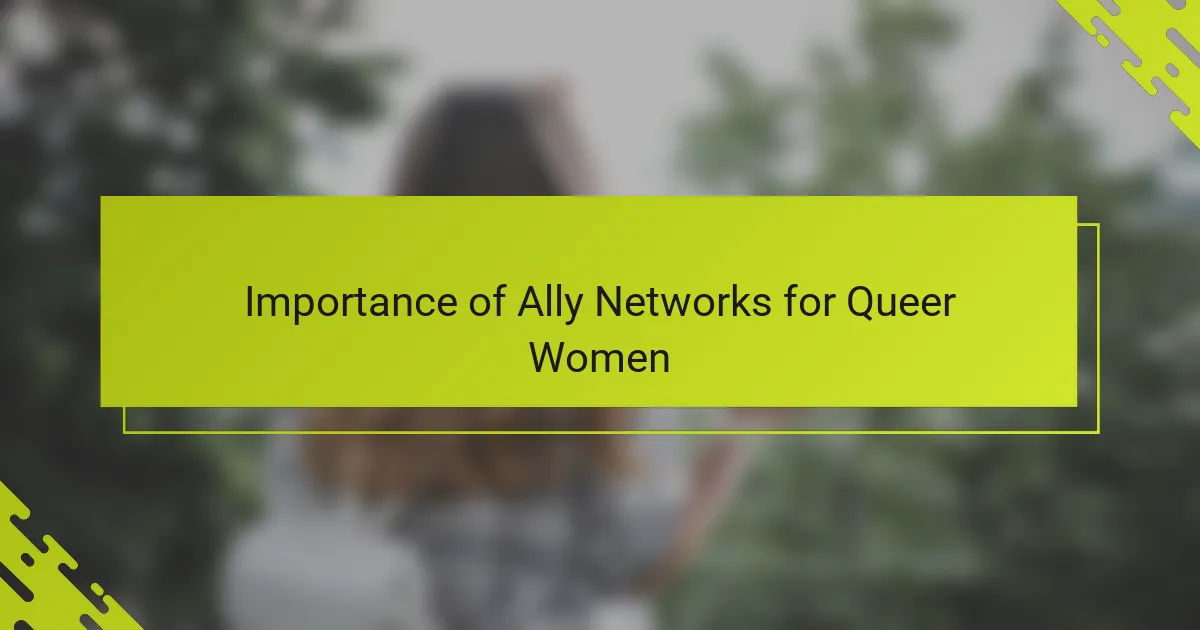
Importance of Ally Networks for Queer Women
There’s a unique kind of strength that comes from knowing you have allies who truly understand the specific challenges queer women face. When I’ve been part of ally networks, I felt an important sense of safety and belonging that extended beyond just feeling “supported.” It’s more than a comforting thought—it’s a lifeline that can make a world of difference in moments of isolation or misunderstanding.
One thing I’ve noticed is how ally networks amplify voices that might otherwise go unheard. These networks create spaces where queer women’s experiences are centered and validated, which is deeply empowering. Have you ever experienced a conversation where your reality was genuinely acknowledged and respected? That feeling is transformative, and ally networks are crucial in making that happen consistently.
At the heart of it, ally networks offer accountability but also hope—hope that change is possible through collective effort. From my perspective, they challenge both allies and queer women to grow, learn, and keep pushing boundaries together. Isn’t that what meaningful support should look like? It’s messy, it’s real, and it’s absolutely necessary.
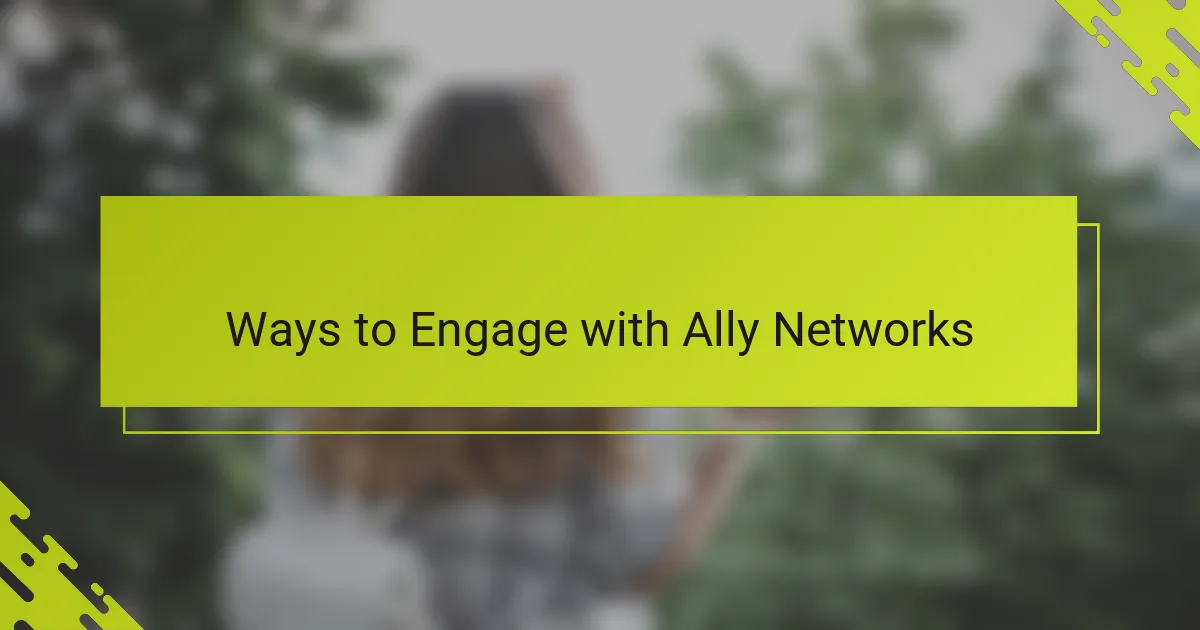
Ways to Engage with Ally Networks
One way I’ve found meaningful to engage with ally networks is by showing up consistently, not just in words but in actions. Whether that means attending events, participating in discussions, or volunteering time, these moments build trust and deepen connections. Ask yourself: what does it truly mean to “show up” for a community you want to support?
Another approach that resonated with me is seeking out opportunities for mutual learning within the network. Sometimes, it’s as simple as asking questions with genuine curiosity or sharing resources that helped me unpack my own biases. Have you ever noticed how engaging openly can turn allies into collaborators rather than just bystanders?
Lastly, I believe that holding space for reflection and accountability is crucial. In one ally group I was part of, we regularly checked in on how our actions aligned with our intentions—a practice that fostered growth and humility. How often do we pause to consider if we’re living up to the promise of allyship, instead of drifting into complacency?

Benefits of Active Participation
Active participation in ally networks transforms abstract support into lived experience. I recall a time when showing up consistently to a local meetup not only expanded my understanding but also deepened the trust within the group. Have you ever noticed how being present—even in small ways—can shift the entire dynamic of a community?
When I engage actively, I find that the benefits ripple beyond personal growth. It’s about creating a collective momentum where everyone feels seen and heard. There’s a unique thrill in witnessing how consistent contributions—whether through sharing stories or lending a hand—can spark real change.
But it’s not always easy; it requires vulnerability and commitment. I often ask myself: am I doing enough to sustain this effort? The honest answer keeps me connected and accountable, reminding me that active participation is both a gift and responsibility that fuels the strength of ally networks.
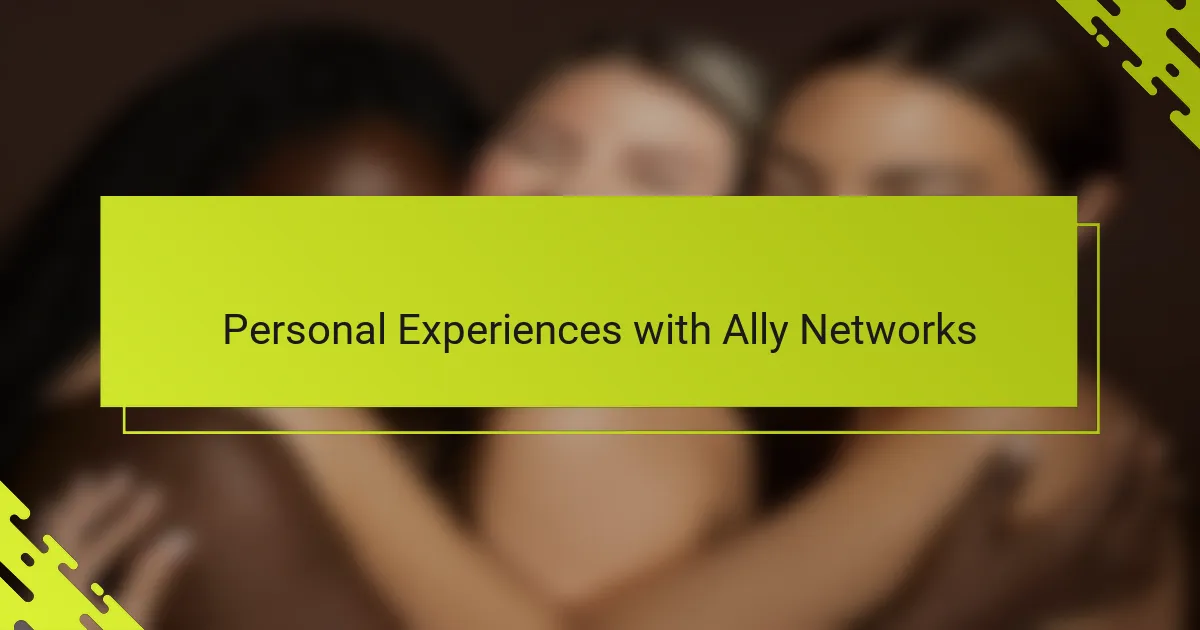
Personal Experiences with Ally Networks
One moment that stands out for me was when an ally shared their own story of grappling with preconceived notions about queer women. That vulnerability created a space where I felt truly seen and appreciated, not just for my identity but for my lived experience. Have you ever experienced a conversation that dismantled walls instead of building them higher?
I also remember the first time I voiced a concern in an ally network and was met with open ears rather than defensiveness. It was a small exchange, but it made me realize how essential trust and respect are for these networks to thrive. How often do we get to speak honestly without fearing judgment or dismissal?
Yet, not every encounter was easy. Sometimes, I felt frustrated when allies missed the mark or needed reminders that allyship is a process, not a destination. Those moments tested my patience but also deepened my understanding of what it means to grow together authentically. Have you faced similar challenges that ultimately strengthened your connections?
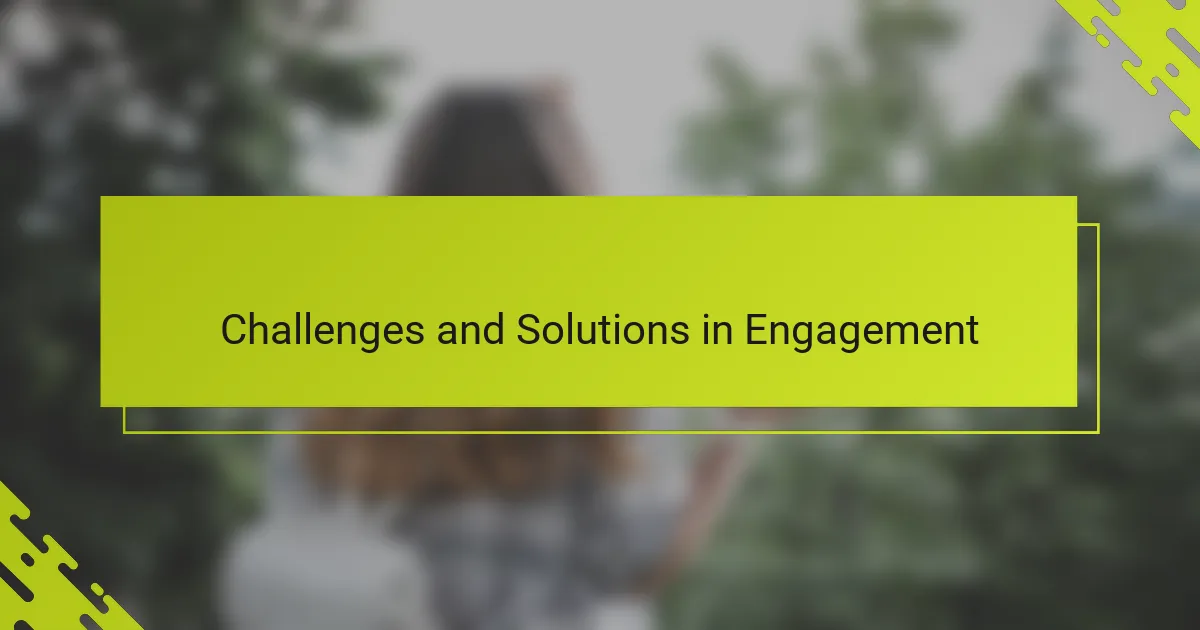
Challenges and Solutions in Engagement
Engaging with ally networks isn’t without its challenges. From my experience, one of the biggest hurdles is navigating moments when good intentions don’t quite hit the mark. Have you ever felt frustrated when an ally’s effort felt surface-level or missed important nuances? It’s a reminder that patience and ongoing dialogue are vital to bridge those gaps.
I’ve noticed that clear communication often becomes a sticking point. Sometimes allies hesitate to ask questions for fear of offending, but silence can breed misunderstandings. What if we shifted toward more open, compassionate conversations, even when they feel uncomfortable? That willingness can transform awkward moments into genuine opportunities for growth.
Accountability, too, is tough but essential. In one network I was part of, we set up regular check-ins to reflect on our actions and intentions. Those moments kept me grounded, reminding me that engagement isn’t a one-time act but a continual commitment. How often do we pause to assess whether we’re really fostering the trust and respect these networks need to thrive?
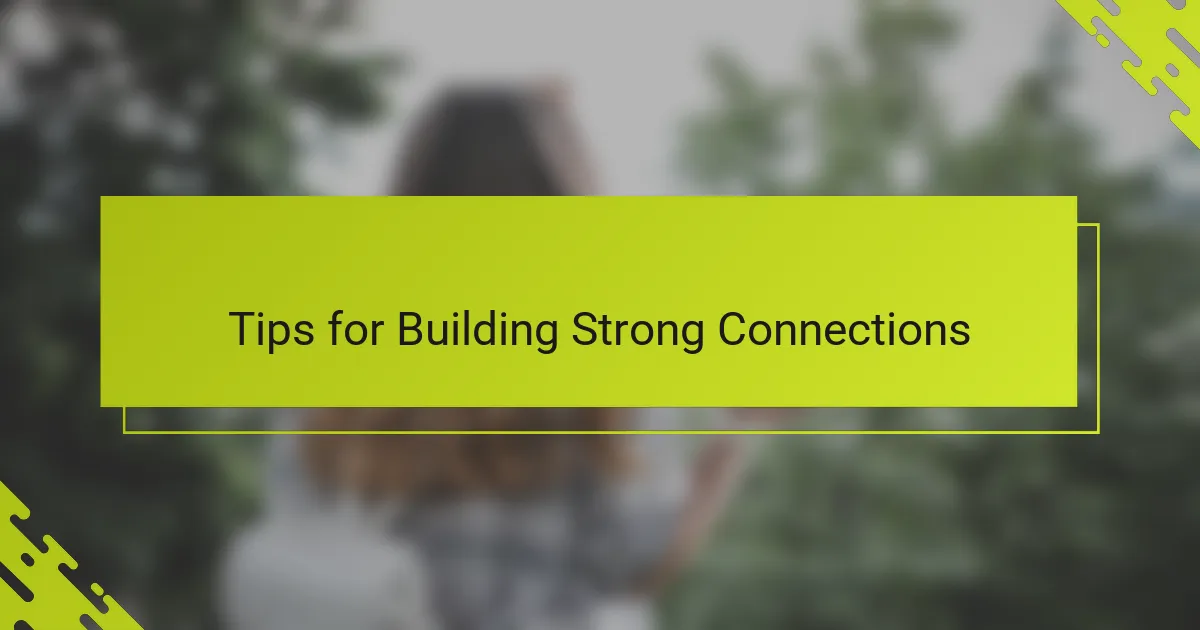
Tips for Building Strong Connections
Building strong connections takes intentionality, and from my experience, showing genuine curiosity is a great place to start. When I took the time to listen deeply and ask thoughtful questions, I noticed how walls of distance began to soften, making space for real understanding. Have you ever felt that moment when a simple question opens up an authentic conversation?
Consistency also plays a bigger role than I initially thought. It’s not just about being present physically but showing up emotionally and mentally, even when it’s uncomfortable. I remember a time when regularly attending a small discussion group led me to form bonds that became foundational—bonds rooted in trust that only grew because I showed up again and again.
Finally, creating room for vulnerability feels essential. I’ve found that when I am open about my own learning curve or mistakes, it encourages others to do the same—and that’s when genuine connections bloom. What happens if we all embraced imperfection in these spaces? For me, it’s been the key to deep, lasting relationships within ally networks.
